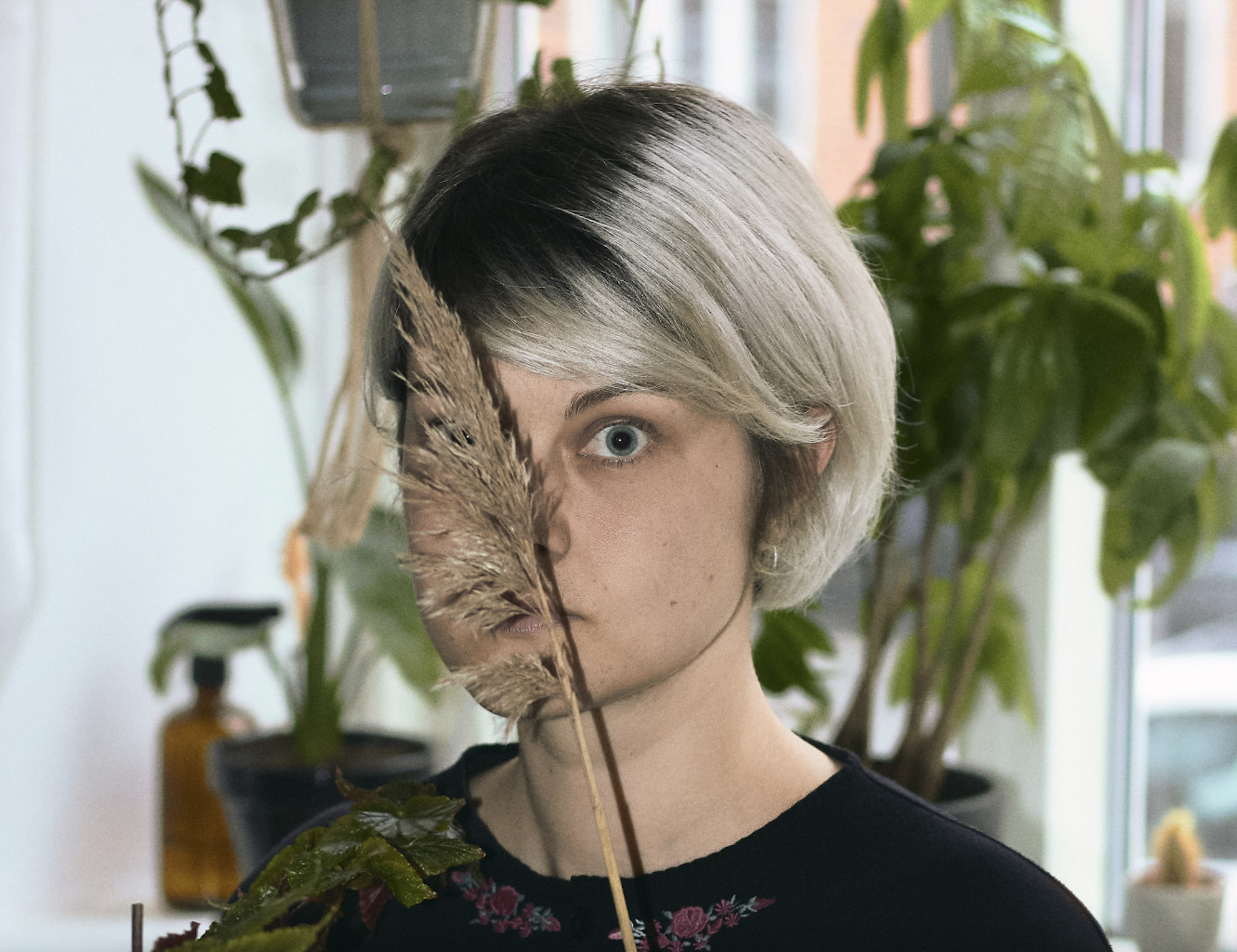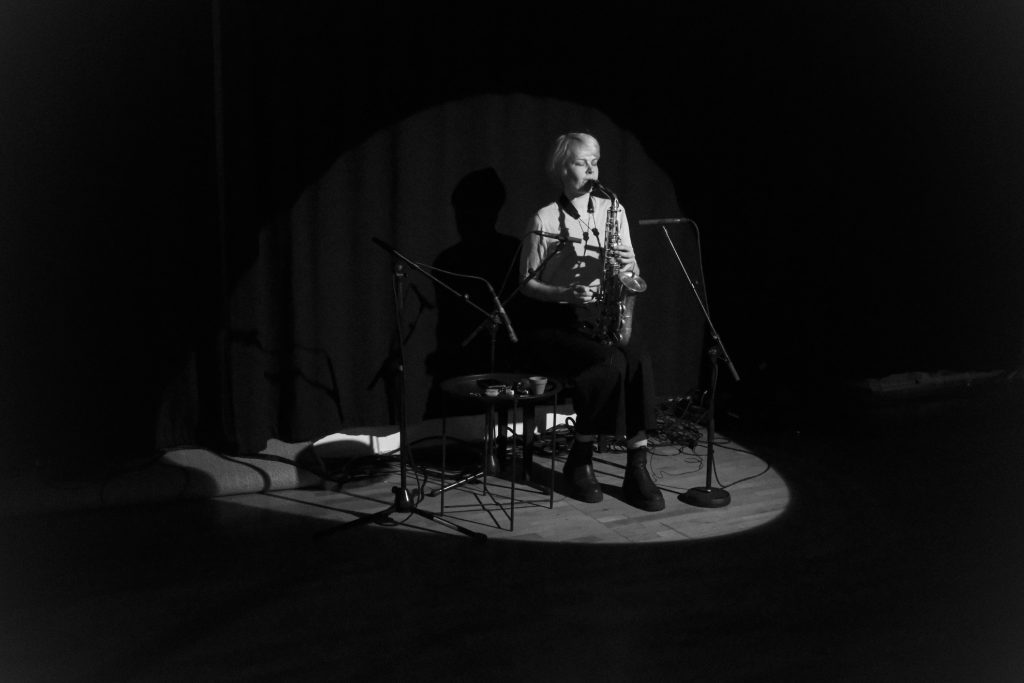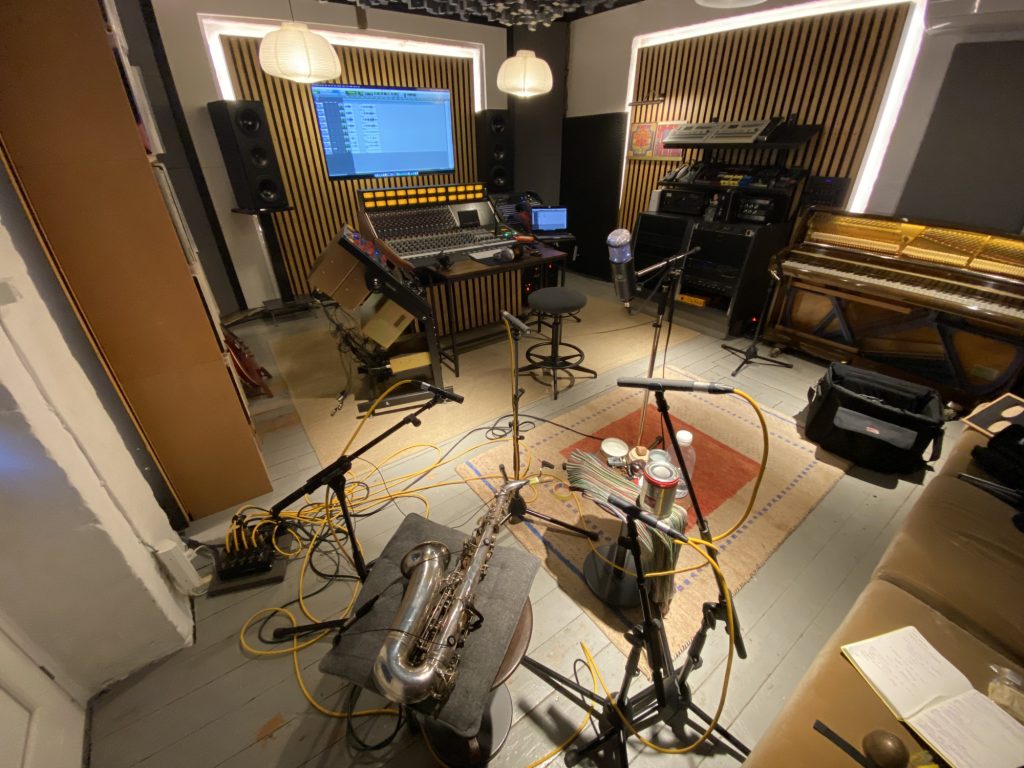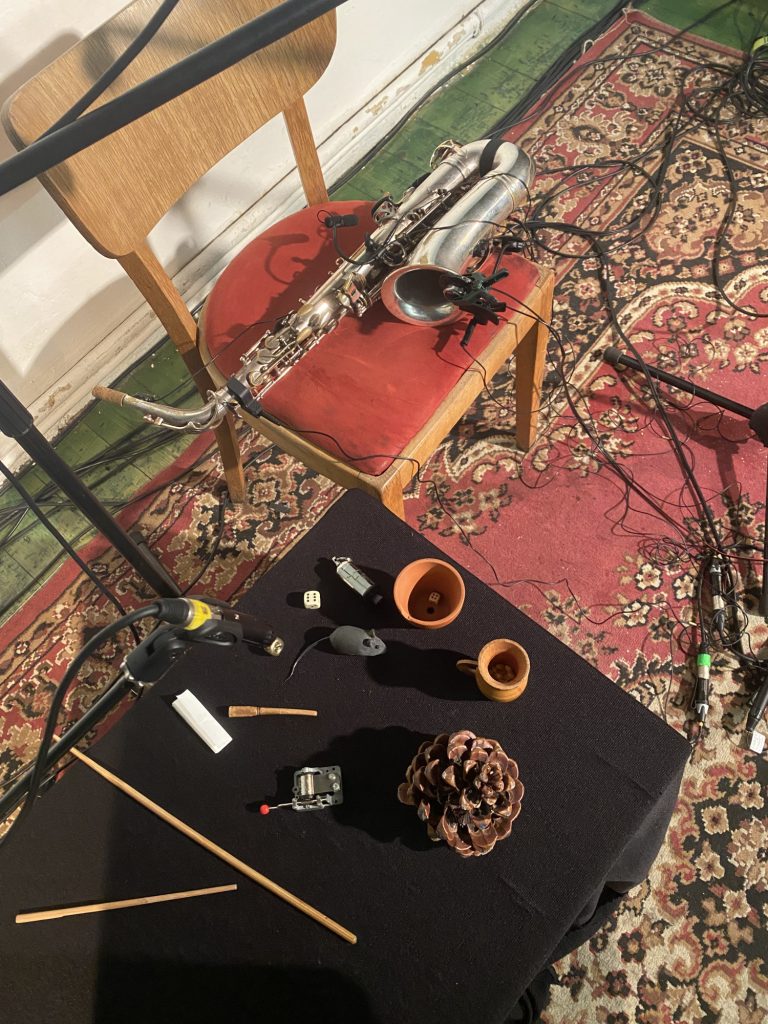Michaela Turcerová’s 33-minute journey into the microcosm of a saxophone
Published July, 2025
by Easterndaze

In the context of contemporary experimental music, you can often jump into conversations about extended playing techniques and how uneasy it is to push their boundaries. This is particularly true when it comes to wind instruments.
However, Michaela Turcerová takes this further. She stuffed the bell of her alto-sax, taped the main keys and shifted the focus onto the hidden details of these newly created microchambers. This approach led to her debut record alene et, released in early winter last year by the Slovak-based experimental label mappa and later recognised as Experimental Record of the Year at the Radio_Head Awards.
On alene et, the Slovak-born, Copenhagen-based musician takes impulsive clicks, sharp breaths and sudden hums, piecing them together into complex rhythmic collages and miniatures. This 33-minute-long metamorphosis of explorations plays with processes typical for electroacoustic music, so it can immediately find you jiggling your knees to an almost juke-style sound. The drum machine here is still the alto-sax.
In this interview, together with Michaela, we talk about the album’s unexpected journey from her teenage classical recitals in Banská Bystrica to late-night sketches recorded on an iPhone, whose lo-fi compression became an unexpected muse.
Ján Solčáni: Your latest album, alene et, references numerous 20th-century musical aesthetics. On the one hand, there are references to pioneers of electroacoustics, such as Iannis Xenakis and his use of space, and on the other, in the track in flux ä, you can hear a sound reminiscent of the now legendary Roland TR-808 drum machine, a device that largely defined the aesthetic of Chicago juke and footwork. At the same time, however, the album doesn’t stray from the formal framework of modern classical music. How did alene et come about?
Michaela Turcerová: The story behind the album is pretty complex. I’m a professional instrumentalist with formal training in the saxophone. I later switched to jazz, and it was actually in Copenhagen, the city where I currently live, that I found my home in contemporary improvised music. This environment is very inspiring, with many folks involved in the contemporary European improvised music scene. I had the privilege of experiencing and hearing many of them in the process of shaping their own musical language through their approach to their instruments. This is what inspired me to find my own unique style and thus craft a sonic world that I would enjoy.
I’ve also been very close to contemporary classical music, especially that of the second half of the 20th century, and at the same time, I’ve been drawn to the rhythm of percussion, in particular that outside Western musical canons. All of this somehow came together in a 33-minute-long album, drowned in the ocean of saxophone sound that I find enjoyable and that gives me meaning.
How did you get into playing the saxophone, and why did you opt for the relatively neutral-sounding alto sax instead of the more sonically colourful soprano or baritone? What shaped your style of playing the alto sax to the form which can be heard on the album?
It all started when I was 13, when I was attending elementary art school in Banská Bystrica. At that time, we had a pretty limited variety of instruments to play. When it came to wind instruments, there was only the clarinet, the transverse flute and the saxophone. The teacher who taught me to play the flute also taught the saxophone, and I didn’t want to stop taking lessons with him. That’s how I found the saxophone. It was more or less an accident. In that period, though, I was quite focused on learning one instrument, mastering it and perfecting my skills. I wanted to be an instrumentalist! This was also evident in the fact that I used to play recitals from classical repertoires. I was still focused on the idea of cultivating one object, taking small steps to advance my possibilities of playing. This has stuck with me – the urge to focus on long-term development.

Photo by Emilia Jasmin
Let’s stick with that for a minute, considering the different ways the saxophone is presented on the album. With a very sensitive ear and a focus on hyperdetail, you explore the body of the instrument, its individual parts and their acoustics with each track. I understand that there’s a role for non-idiomatic techniques, and that they have a place in the history of modern composition. But I find your approach to recording very interesting, especially considering that the saxophone is traditionally amplified using a directional microphone on a gooseneck placed on the bell of the instrument. What’s your approach when it comes to using sound recording technologies with the saxophone?
It’s exactly as you described it. The whole album is a tribute to the sonic possibilities of a solo instrument, in this case the alto saxophone. Before working on this record, I was interested in exploring extended techniques with the desire to break away from the traditional sounds of the instrument, or the ones you’d normally expect from it. To discover other sonic spectrums, percussive sounds and other qualities of the saxophone. However, when exploring extended techniques, I ran into limitations. The technique of playing changed, but the object remained the same. So I began to mute the saxophone bell. It’s the part of the instrument that is usually picked up by the microphone as the primary sound source. Next, I slowly started muffling the main keys of the saxophone, used to modulate pitch, with some plastic pads. This lets me focus on the side keys, which are used to play altered and chromatic tones and aren’t as dominant in the way the instrument sounds. It was a really intuitive process. In a way, I created a closed space, a microcosm, out of the saxophone body. In the recording process, I used this modified saxophone to gradually record each key. In the end, I used about six microphones, five of which recorded the individual details of the instrument and one for the studio space itself. These details form the core of the record.
So what happened next? Did you prepare any samples or libraries from these recordings and use them to compose the album within a DAW interface? How did the composition process work?
The post-production process was quite long and laborious. Before the actual recording process, I spent about a year just exploring the possibilities of playing the saxophone in this modified state, without recording anything in the studio. Suddenly, I found myself with a different object in front of me, one that I wanted to explore and get the most out of. At the same time, I wanted to keep a certain intuitive approach. I did some small sketches of the process, recorded them on my iPhone and listened to them bit by bit. What caught my attention in these recordings was the degree of compression the phone applied when recording. This unpredictable factor inspired me quite a lot. It doesn’t sound like that acoustically, but it was this unintentional lo-fi that kicked me into thinking about how to take the instrument further. At the same time, I wanted to avoid conceptual music and simply work my way through discovering the instrument’s limits. Nothing on the album exists as sheet music. I approached the instrument through its physicality. I understand it as an extension of my own body. That’s what I enjoy about it, this connection to the instrument.

In the studio. Photo by Michaela Turcerová
Staying with the physicality of the media, the iPhone also presents certain limitations, either in terms of content or form. And you’ve found your aesthetic in this. How do you approach the physicality of the instrument or the medium you work with? Do you take a more conceptual approach, or do you focus more on the material limitations?
I never wanted my work to sound too academic or conceptual. What I found interesting was picking one element of the instrument and using it as a building block. Saying to myself, okay, now I’m going to play for 15 minutes using only this one element, and I’m going to try to find all its nuances, details and variations, just by playing it over and over again. This is where I think the physicality of my approach to playing comes from. Music that is produced manually, through experience with the instrument in time.
Do you think it would be possible for you to get to the same result by remaining in a digital environment? In a situation where you wouldn’t have any haptic experience with the instrument itself?
I can definitely see myself working with electronic music in a few years. I think I’m aesthetically quite close to it. But I need to find a suitable approach that allows me to work comfortably. I think that, even in a DAW environment, I’d be able to focus solely on my own understanding and perception of sound. However, I cannot imagine myself working on this album from scratch, from the blank default screen of some software’s user interface. For me, the important part of the whole process of recording this album was actually sitting with the instrument.

Michaela Turcerová performing Spectrals at n:ear festival 2023. Photo by Karolina Gordziewicz
When listening to your work, there’s often a certain need to explore the space in which the sound propagates. Whether that’s the enclosed body of the saxophone or more site-specific compositions, such as Spectrals, composed for saxophone, church bells and feedback, and performed at the n:ear festival in Banská Štiavnica in 2023. How do you approach space and the relations that form within it in the context of your music?
That’s something I’ve been thinking about quite intensely in the last few years. Music, or sound, doesn’t exist in isolation. It always depends on the context and conditions in which the sound occurs.
To clarify, in the past, I was a big fan of acoustic music, trying to bring all the intensity and intimacy of music to the audience using only acoustic means. With improvised music, I became interested in how different concepts work in different spaces. Here, I realised the role that space acoustics plays.
Before I started performing solo, I was interested in collaborating with larger ensembles. I often tried to get these larger groups to escape the stage, for example, by placing the musicians in different positions within the space, not necessarily just on the stage. I find this very enjoyable, being aware that a single space offers a multitude of positions from which sound can be perceived. For me, this represents a certain challenge, exploring the limits of what can be achieved within a given space, so it still makes sense musically.
To me, sound and music don’t appear as isolated phenomena. They depend on the whole range of circumstances surrounding the process of creation and the performance itself, like the position of the microphones and speakers in the space, or the position of the percussionist. The space is part of the composition. It can change the audience’s perception and their ability to engage in the performance itself. An example of this was the site-specific performance Spectrals, or the performance by the Ruiny Collective, played together with David Petráš and Štefan Szabó, which we performed in an abandoned grain silo in 2021.
Was there a specific impulse that led you to decide to start working solo? At what point did you find yourself thinking, “OK, now I’m going with my own voice”?
It’s a kind of personal development for me. I truly believe in mutual collaboration and trust it deeply; that’s why I’ve often set great store by it. But about two or three years ago, I felt the need to find my own musical voice. This probably had something to do with my mindset at the time. I was part of various music institutions and was still getting my formal education. I wanted to know where I stood in this environment and understand who I was as a musician. What I know and what I want to say when I’m standing alone on stage.
The moment when I started to seriously think about my solo project was preceded by a really bad solo performance, which made me feel terrible. This experience shook my musical identity. I realised I didn’t know who I was and where my position in music lay. I had no idea how to prepare for it. I was an instrumentalist who suddenly sat down in a chair on stage. I thought I had something prepared, but I was just in a strange state of disillusionment. After this experience, I asked myself what I could do with this, and I realised that it was the process of creation itself that I wanted to focus on.

Photo by Michaela Turcerová
Have you got any ideas about how you want to continue with your solo project after this album?
This year, I’m focusing on performing this album live. It’s quite time-consuming –finding the right microphone positions that will suit the live set, and so on. I’m collaborating with a sound designer who’s helping me with a more elaborate microphone setup. I’m still in some kind of a post-album phase. But I don’t want to just keep playing it back the same way. I’ve found some new techniques and started using my voice a little bit. The work with my voice comes naturally from how I approach the saxophone itself. When playing, I often think about the fact that I’m basically just breathing into an object that’s like an extension of my diaphragm. It’s not just about the air. The voice itself, even if only in a small form, travels through the individual keys of the saxophone. But I don’t have any specific idea of where I’ll go after I stop having fun with this.
Let’s go back to the idea of collaboration for a moment. Even in the context of your solo project, a certain form of collaboration is present, in which you and the sound engineer add another dimension to the performance. Even now, you’re an active member of various ensembles. How important is it for you to work with other people, or to feel connected to them?
Being able to work together is important to me. Creating together has always brought me joy. It sounds simple, but the possibility of looking at problems together and discussing them has always allowed me to go further than I would have been able to go on my own. Currently, I’m part of two relatively active and non-hierarchical bodies, and it’s very enriching. I like the openness; it requires a huge amount of communication, where the end result is emotional for me, which I really need.
The sense of community, the mutual love that’s transformed into work, and the opportunity to be myself and go deeper, not only in music but also in other aspects of everyday life, are important to me. The result is thus taken to a whole new level in this way.
And yet you’re still on the move. You’ve lived in several countries, been involved in various scenes and experienced different models of music education. Do you think that this flux, moving from place to place, and the associated aspects, such as flexibility, curiosity, but also a sense of uprootedness, are somehow present in the way you create?
I think it will take me years to fully understand how these personal geographies have affected me. I’ve been thinking about it a lot. It’s been eight years since I left Slovakia, and I feel a certain sense of uprootedness. I find myself somewhere in between, between spaces, between mentalities – trying to absorb it somehow, to find my bearings mentally. What I realise about myself is that I’m a very curious person. That’s why I left and therefore had to make a few compromises, for the sake of my curiosity. I knew I wanted to meet new people and discover new cultures, and create together. It was this experience that led me to discover what I now consider important to express and capture on my instrument.
What’s inspiring your work at the moment?
At one point in my life, I thought I was everywhere. I had the whole world ahead of me and wanted to explore every corner of it. I was a bit lost in that. For the last two years, through the support of a network of international musicians based in Copenhagen, all the friendships that have come out of that and the atmosphere of the local scene have been really inspiring for me. But I also enjoy travelling and getting to know other local scenes.
I like to learn something from other enthusiastic people, to see what their structures are like and how they create their own underground scenes. My inspirations are closely linked to people. However, I also think about how to approach work as such. I’m a musician, and that’s my work. I’m looking for balance.
Are you in touch with or following the current experimental scene in Slovakia?
It’s mainly thanks to the activities of the mappa label and Jakub Juhás, but also by following the work of Štefan Szabó, that I’m keeping an eye on what’s happening in Slovakia, and it makes me happy.
Sometimes I find myself in a kind of cloud, where I imagine how one day I might move to Bratislava or another city, where I could contribute to shaping the local scene, not just staying in Copenhagen and feeling uprooted. As I mentioned, I enjoy following the scene in Slovakia. It’s very lively with many young musicians, and I enjoy listening to new music from the region. There’s so much happening that I can hardly keep up.
Although the situation has changed significantly in recent years, the experimental and improvised music scenes are still male-dominated environments. It’s not entirely unusual to be the only woman in the room or the tour van. How do you navigate these environments?
Compared to, say, the last ten years when I was still at university, it’s much easier to meet female musicians in Slovakia and the Czech Republic now. But Scandinavia spoiled me in that respect.When I started in Slovakia, and later when I moved to Prague, I was almost always the only female musician both at school and elsewhere. Unfortunately, this also led to many unpleasant situations. When I came to Copenhagen, I encountered a large number of avant-garde female musicians. Having the chance to hear and meet Lotte Anker, Maria Faust, Kaja Draksler, Marcella Lucatelli or Ada Rave has definitely shaped me profoundly.
The experience of being the only woman in the room has now almost completely disappeared – and in the few groups where that’s still the case, I’ve been fortunately working with very sensitive and respectful people.Over time, I’ve experienced that the working environment can only benefit from diversity, and I’m happy to see more curators, directors, festivals or educational institutions taking active steps toward the change of conventional power structures. But it’s a difficult process.It’s probably also because I’m a little older now, which has allowed me to find a certain healthy self-confidence in how to deal with this kind of situation. I have also gone through a process of unlearning some of my own stereotypical gender-related assumptions. I hope that in the future I will see a greater presence of non-male artists and teachers, those who can be role models for the next generations.
Reading some of the reviews of your album, I noticed some negative comments referring to its fuzzy or blurred nature, noting that, with its short duration, the album presents an idea that it doesn’t develop further, or that varies too quickly. I feel that I have frequently encountered a certain fixation on expected or established patterns in this type of commentary – what the form of something should be and how it should sound. To what extent do you clash with the conventions of how something should be done and sound in your practice? Is there any way to escape these patterns?
When I read the first review that wasn’t entirely favourable towards the album, it affected me quite a bit. My first release, my first child, was dismissed like that. And yet I had been working with the format of miniatures for several years. I found it to be a fresh format.
I’ve been thinking a lot about where these expectations come from, that something is compositionally off, or that the pieces are too short. But for me, there’s nothing unusual about it. I’ve come across recordings like this in music from Africa, for example.
These collages are small improvisations. I don’t think it’s a fault to create something that doesn’t want to be categorised, but just wants to be an honest expression. Maybe it’s just unusual to have something so short and call it a music album. I don’t know – maybe it doesn’t fit into the standardised boxes of musical formats.
Paradoxically, though, I’ve only come across negative comments in reviews alone. When performing live, sharing my music with others in a physical space, all I’ve encountered is openness. The people I share the space with have the chance to see me focused, producing it all, and taking it really seriously. That experience of sharing a moment together is very valuable to me. I’ve had very positive experiences in these situations.
Of course, writing about music is a different kind of game. There are a lot of variables. You approach the album as a product, where you only see the cover image and some song titles. The person behind it isn’t present, just their name. Forming an opinion and finding one’s context and deciding on a certain viewpoint, in which nobody directly asks me for my opinion, must be challenging. In a way, it’s very impersonal. I think I’d prefer if the opinion were shaped after some kind of dialogue and shared curiosity about the music…
… you feel there’s some absence of a connection.
Basically, yes. But the connection is there because I was affected. Then I realised that I was just an object in this situation. Maybe one of many albums reviewed during the day. The person reviewing has a connection to my work and their job, not to me.
What are your next plans?
I’ve got a few solo concerts coming up. I’m also writing music and preparing a recording for an ensemble with which, as I mentioned earlier, we play around with the possibilities of space. It’s a group of seven musicians, an analogue electroacoustic ensemble consisting of two percussionists, a double bass, three wind instruments, a saxophonist playing reel-to-reel and vocals. So far, we’ve performed live only, where I worked with the positioning of the individual instruments and performers. In the acoustic version, this was achieved by positioning the percussion instruments within the space. When the reel-to-reel was added, we placed the speakers in such a way that the sound filled the entire space. Now I’m thinking about how to adapt this in a way that I’ll enjoy in a studio setup and on a recording.Michaela Turcerová. Photo by Jasmin Mebrouk
Originally published by 34.sk. This article is brought to you as part of the EM GUIDE project – an initiative dedicated to empowering independent music magazines and strengthening the underground music scene in Europe. Read more about the project at emgui.de.
Funded by the European Union. Views and opinions expressed are, however, those of the author(s) only and do not necessarily reflect those of the European Union (EU) or the European Education and Culture Executive Agency (EACEA). Neither the EU nor EACEA can be held responsible for them.